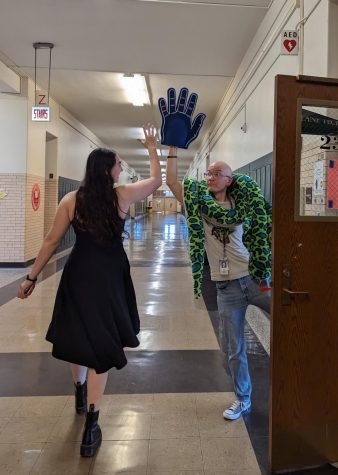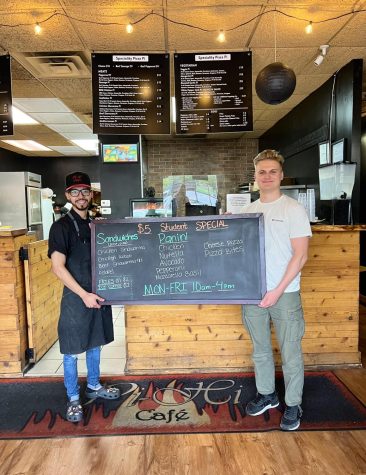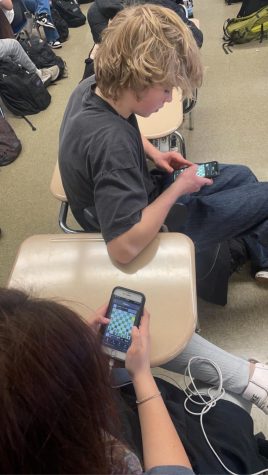Building up Adaptive Robotics
November 2, 2015
When the bell rings signaling the start of fifth period, a group of eight or nine kids rush into Room 129. Instead of setting their backpacks down or taking their seats, they all rush to grab a box of Legos.
With their assigned boxes in hand, they sit down and build. One student is working on a robot, another just finished building a boat. All of them are fully engrossed in their tasks; some biting their lips in concentration while others look between a Lego manual and the pieces.
Every fifth period in Room 129, Mr. Durham – a physics and robotics teacher – teaches Adaptive Robotics to high-functioning autistic students. The class was designed by two students on the robotics team last school year. Mr. Durham and Ms. Deweese, a Special Ed teacher, helped make the class possible.
“Two students on the robotics team actually designed the class and they came to me to see if I was interested in teaching it. They filled out the necessary forms and I just made it official,” Durham said.
When CPS approved the new course, Durham said, the class became available to all public schools in Chicago. Lane is the first school in the city to teach Adaptive Robotics. To help sponsor the class Mr.Durham and Lane partnered with Have Dreams, a private school for autistic children in Evanston.
The class is in its early stages the students are playing with Legos now – but Mr. Durham hopes they can move to more advanced projects once they get the basics down.
“We’re in between projects now. They just finished building a two-wheel car. They got to program the car directly by manipulating the code. They made it go in circles and play music,” Durham said.
Legos are just the starting point for the students in Adaptive Robotics. They are using the Legos to build a foundation for future projects. The skills they are learning will help them down the line when the class starts to progress.
“They are learning to follow procedures, learning how to follow a list of directions. We are laying the groundwork down so we can move on to bigger projects,” Durham said.
One of the projects could potentially be the NAO Robot, a humanoid – a robot with its body shape built to resemble a human body – who can understand and obey commands.
According to Aldebaran Robotics,“NAO robot is a friendly and intelligent companion, who you can program to understand you and meet your every need.”
Durham is optimistic that NAO will help the students articulate their words. Durham has applied for a Google Grant and is in the process of applying for another grant to cover the cost of NAO.
“It’s a robot. It understands commands. But those commands have to be clear or it won’t understand. In order for the kids to interact with it they have to speak clearly. The kids can interact with it, and talking to NAO can help their verbal communication,” Durham said.
In the front of the classroom, one student cannot find a needed Lego piece to complete a robot’s arm. Some students are assigned a buddy. The buddy’s job is to find any pieces the student may need.
Edgar Lopez, Div. 665, is on a mission to find a gray piece to complete the platform of a robot his partner is building.
“Mostly we help find a piece – if they get stuck I’ll step in. But they’ll get pretty good at building the model themselves,” Lopez said.
As each student is working on his or her own model, Mr. Durham and adult aides walk around the classroom. They make sure everyone is on task and hand out high-fives whenever a student holds up a Lego model, some in the beginning of production and some already finished.
“It’s a good class for them. They get to develop the techniques – do things in an orderly fashion. They get to use their minds a lot,” Lopez said.
A student in the back of the class is done playing with his Legos. Durham gives him a metal contraption and a wrench and tells him to take it apart. As the student unscrews bolts, he talks about the Bulls and his new hat.
“I love it here, I love this class,” he said.
Durham finds high reward in this class. He thinks it is important for the students to learn about technology. When they get out of high school, Durham said, jobs are going to require them to use different technology.
“A lot of these kids are capable of logging onto the computer and typing in videos on YouTube. But I want them to use technology to meet a goal. I want them to be productive, I want to see what they are further capable of,” Durham said.
Another student has just finished building a boat. An aide stops in front of him. She makes him hold up the boat as she pulls out her phone to snap a picture. The student, in a Minions T-shirt, holds out his boat and smiles proudly. He smiles so wide that he rubs his cheeks after the aide walks away.
“I want to make this class as rewarding and engaging as possible. And hopefully, one day, other schools will adopt this program,” Durham said.






